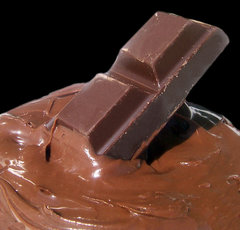Cocoa
|
|
Cocoa may refer to either the dried and partially fermented fatty seeds of the cacao tree, which are used to make chocolate; or, more usually in the United States, to cocoa powder, the dry powder made by grinding the seeds and removing the cocoa butter. Hot cocoa is often confused with hot chocolate, but hot cocoa is made from the cocoa solids, while true hot chocolate is made from whole chocolate.
| Contents |
History
Chocolate and cocoa are made from the beans of the cacao tree, which apparently originated in the foothills of the Andes in the Amazon and Orinoco basins of South America. The tree was introduced into Central America by the ancient Maya, and was cultivated in Mexico by the Toltecs and later by the Aztecs.
Cocoa was an important commodity in Pre-Columbian Mesoamerica. Spanish chroniclers of the conquest of Mexico by Hernán Cortés relate that when Moctezuma II, emperor of the Aztecs, dined he took no other beverage than chocolate, served in a golden goblet and eaten with a golden spoon. Flavored with vanilla and spices, his chocolate was whipped into a froth that dissolved in the mouth. No less than 50 pitchers of it were prepared for the emperor each day, and 2000 more for nobles of his court.
Chocolate was introduced to Europe by the Spaniards and became a popular beverage by 1700. They also introduced the cacao tree into the West Indies and the Philippines. It was used in alchemical processes, where it was known as Black Bean.
Today, most of the world's crop of beans is grown in equatorial Africa, especially on the Gold Coast, and a small amount in South America, chiefly Brazil. The use of chocolate, cocoa and other products is world-wide. Belgium has the highest per capita consumption of cocoa at 5.5 kg, ten times the world-wide average ([1] (http://www.fas.usda.gov/htp2/tropical/1997/97-10/cocoapercap.htm)).
Prices for the commodity reached a five year high in November 2004; this is because exports from Côte d'Ivoire are likely to be cut due to escalating violence in the region.
Harvesting
A pod has a rough leathery rind about 3 cm (1½ inch) thick. It is filled with slimy pinkish pulp, sweet but inedible, enclosing from 30 to 50 large almond-like seeds or "beans" that are fairly soft and pinkish or purplish in color. As fast as they ripen, the pods are removed with a curved knife on a long pole, opened with a machete, and left to dry until taken to fermentation.
There the beans are removed and piled in heaps, bins, or on gratings where, during several days of "sweating", the thick pulp ferments until it thins and trickles off. The quality of the beans, which originally have a strong bitter taste, depends upon this sweating. If it is overdone they may be ruined; if underdone they have a flavor like raw potatoes and are liable to mildew.
Then the beans are spread out, constantly raked over, and dried. On large plantations this is done on huge trays, either outdoors by sunshine or in sheds by artificial heat. However, thousands of tons from smaller producers are dried on small trays or on cowhides. Finally, the beans are trodden and shuffled about (often using bare human feet) and sometimes, during this process red clay mixed with water is sprinkled over the beans to obtain a finer color, polish, and protection against moulds during shipment to factories in the United States, the Netherlands, United Kingdom, and other countries. About 3,000,000 tonnes of cocoa are grown each year. The Netherlands is the leading cocoa processing country, followed by the U.S.
Producing chocolate
To make 1 kg of chocolate, about 300-600 beans are processed (for a pound of chocolate, about 150-300 beans). In a factory the beans, after being washed and roasted, are de-hulled by a "nibber" machine that also removes the germ. The nibs are ground between three sets of stones until they emerge as a thick creamy paste. Cocoa powder is made from this "liquor" by removing part of its fatty oils (the "cocoa butter" used in confectionery, soaps, and cosmetics), either with a hydraulic press or by using the Broma process. With starch and sugar added, the liquor is churned and beaten in a "Conges" machine to produce sweet chocolate.
Adding an alkali produces Dutch process cocoa powder, which is what is generally available most everywhere in the world except the United States and has less acidity. Regular or nonalkalized cocoa is lighter in colour and sharper in flavour. It is acidic, so when added to recipes with an alkaline ingredient like baking soda, the two react and leaven a product. Dutch processed cocoa is alkali-treated and is less acidic, darker and more mellow in flavour.
- (based on text from the public-domain Web site of the Argonne National Laboratory)
Use of cocoa
Uses of cocoa are numerous. It may be used in cakes, creams, drinks, toppings.
Besides its use as a food, science has discovered that cocoa is beneficial for health. Cocoa has nearly twice the anti-cancer antioxidants of red wine, and up to three times those found in green tea.
Issues with cocoa as a commodity
- Many cocoa farmers receive a low price for their produce. This has led to cocoa and chocolate being available as 'fair trade' items in some countries, but this fair trade remains a tiny percentage of total trade.
- Slavery has commonly been used in its production: see Cocoa Protocol for an effort to end this.
- Pollination is exclusively by midges, which may be affected by pesticides
See also
- Theobromine, an alkaloid present in cocoa
- Chocolate
- Cacao
External link
es:cacao fr:Fève de cacao he:קקאו it:Cacao (alimento) pl:Kakao ja:ココア nl:Cacao nn:Kakao sv:Kakao


